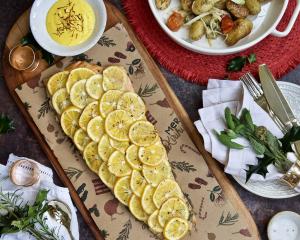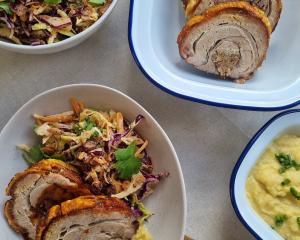
Juggling each child's likes and dislikes along with school rules on what is suitable and what is not not can make preparing a school lunch a real chore.
At the end of the day it comes down to being organised and even a bit sneaky.
United Kingdom nutritional specialist Lucinda Miller in her new cookbook The Good Stuff advocates the sneaky approach to getting fussy or unwilling children to eat the ``good stuff''.
She suggests pureeing lightly steamed vegetables and freezing it in small quantities to add to muffins, sauces, soups, mashed potato and even pancakes.
Grating vegetables is another way to add goodness on the quiet and they disappear into muffins and brownies with hardly a trace.
Variety is key: plenty of vegetables and fruits, some carbohydrate for energy, and protein to sustain them.
Frittatas or crustless quiches are a great way to incorporate vegetables - broccoli, courgette, capsicums, corn - and plenty of protein - eggs, fish, cheese, ham or bacon.
Best of all these can be made quickly the night before and any leftovers can be frozen for another day. Making them in muffin tins makes them easy to eat for little ones and easy to freeze.
Little meatballs - chicken, pork, beef or lamb - are another great option. Vegetables can be grated to add moisture to the mince. Miller even grates pear to go in her chicken balls and apple as an accompaniment to pork.
Children can eat these with a homemade tomato passata, wrapped in a lettuce leaf or in a pita bread with some salad - a small pottle of plain yoghurt or chutney to dip them in on the side is nice.
For a snack, vegetable dip with fresh vegetable sticks never goes amiss. Peas, beetroot and pumpkin can all be pureed with chickpeas, butterbeans or cannellini beans to create a smooth dip. Add a little lemon juice and herbs for extra punch.
Fritters are another easy option and a great way to use up leftover vegetables - mash, grate or cut vegetables such as cauliflower, courgette, corn or kumera.
Wraps come in all sorts of flavours and are a quick and easy alternative to bread. Just spread with some vegetable dip, add some finely chopped or grated salad ingredients, vegetables and chicken, ham or fish and roll up.
A sweet treat is always a favourite in any kid's lunch box, but the trick is to keep away from highly-processed sugar products and look out for low or unrefined sugar products. You can use dates or maple syrup as a sweetener mixed with wholegrains.
And, of course, remember the drink bottle - keeping hydrated helps concentration.
Here's some inspiration from Fresh's archives:
 Photo: Simon Lambert
Alison Lambert's fritters
Photo: Simon Lambert
Alison Lambert's fritters

Makes 8 medium-sized fritters
Ingredients
2 cups cauliflower florets (bite-sized pieces)
3 cups broccoli florets (bite-sized pieces)
1 large egg
¼ cup flour
¼ cup chickpea flour
⅓ cup finely grated parmesan cheese
pinch caraway seeds
½ tsp salt, plus more to taste
freshly ground pepper
oil for frying
Method
Begin by preparing the cauliflower and broccoli.
I like to keep them bite-sized as I like to keep the texture of the vegetables, but you also need the fritters to stay together.
I also use the stems of the broccoli to add wonderful texture and more flavour.
I peel off the tough outer layer and then slice them into thin rounds.
Steam your cauliflower until tender (this will only take a couple of minutes), and then continue with the broccoli and stems.
It is important not to overcook them as you don't want mushy vegetables.
In a large bowl, lightly beat your egg. Add the flour, cheese, caraway seeds, salt and pepper.
Then, add the cooled cauliflower and broccoli.
Using a potato masher, mash the vegetables just a little as you're looking to keep the bits recognisable, but small enough that you can press a mound of the batter into a fritter in the pan.
Once mashed a bit, gently fold the ingredients together the rest of the way with a spoon.
Adjust seasonings to taste.
Heat a large, heavy frypan over moderate heat. Once hot, add a good glug of oil, about 2 to 3 tablespoons.
Once the oil is hot, scoop a dessert spoon of the batter and drop carefully into the pan, then flatten it slightly with your spoon or spatula.
Repeat with additional batter, leaving space between each. Once golden underneath, about 2 to 3 minutes, flip each fritter and cook on the other side until equally golden, about another 1 to 2 minutes.
Transfer briefly to paper towels to drain, then to a serving plate if you'll be eating them shortly or a baking tray in a warm oven if you'd like to keep them warm for a while until needed. Repeat with remaining batter, adding more oil as needed.
Serve with lemon and lightly-salted yoghurt.
The wraps I have suggested using are soft and flexible and do not crack or split when rolled. They do not need to be heated before use.
 Photo: Linda Robertson
Joan Bishop's smoked chicken, pea and pesto wraps
Photo: Linda Robertson
Joan Bishop's smoked chicken, pea and pesto wraps

Makes 7-8 slices per roll
Ingredients
2 large wraps (25cm diameter; I like Farrah's garden
spinach and Freya's spinach and garden herb)
250g frozen baby green peas (not minted)
½ cup fresh basil pesto
½ tsp salt
1 Tbsp sour cream
6 Tbsp grated parmesan cheese
250g skinless, boneless smoked chicken
⅓ telegraph cucumber, peeled, seeded and cut lengthways into thin strips
½ red capsicum, deseeded, cut into thin strips
2-3 Iceberg lettuce leaves, finely shredded
Method
Cook the frozen peas according to packet instructions. Drain well and cool.
Puree in a food processor with the basil pesto, salt, and sour cream until well blended.
Spread the pea puree evenly over both wraps, taking it right to the edge.
Scatter with grated parmesan cheese.
Shred or finely slice the chicken and place on the bottom third of each wrap. Place the cucumber strips, capsicum strips and the shredded lettuce evenly on top of the chicken on both wraps.
Roll tightly to enclose the filling and place seam side down on a sheet of plastic food wrap. The rolling of the wraps is the trickiest part and it's not difficult. Roll firmly, tucking in any filling that falls out.
Roll the filled wraps tightly in plastic food wrap, ensuring the ends are enclosed. Refrigerate for an hour to firm or for up to six hours if more convenient.
Remove plastic wrap and trim the ends. Cut the roll into slices approximately 3cm thick. If there are any little gaps in the stuffing, simply pop in some extra chicken or salad.
 Photo: Getty Images
Dee Copland's gluten-free buckwheat pancakes
Photo: Getty Images
Dee Copland's gluten-free buckwheat pancakes

Serves 6-8
Ingredients
½ cup buckwheat
1 large free-range egg
⅓ cup almond/coconut milk
½ tsp baking powder
1 tsp coconut oil, for cooking
Method
Whisk together the egg with almond/coconut milk. Add the buckwheat flour and baking powder and whisk until smooth.
The batter should be thick, but pourable. Add more liquid, if necessary.
Heat a frying pan on low to medium heat, add oil.
Pour small batches of batter into the frying pan and cook for 2-3 minutes or until small bubbles appear. Turn and cook for another 1-2 minutes.
Transfer to a plate and repeat.
Serve with some fresh/defrosted berries and almond butter or fresh fruit and coconut cream or leave plain for school lunch boxes.
These also freeze well (separate with baking paper before freezing) and can be defrosted in the toaster for another easy breakfast option.












